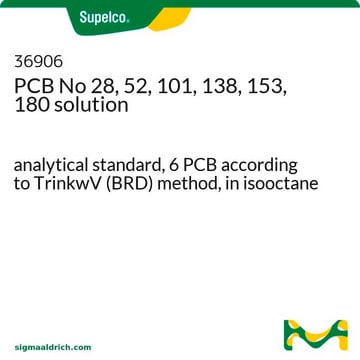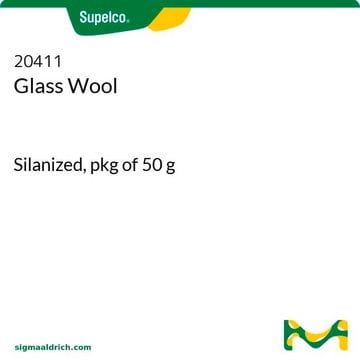35588
PCB No 5
analytical standard
Synonym(s):
2,3-Dichlorobiphenyl, 2,3-PCB
Sign Into View Organizational & Contract Pricing
All Photos(1)
About This Item
Empirical Formula (Hill Notation):
C12H8Cl2
CAS Number:
Molecular Weight:
223.10
Beilstein:
2209551
Ballschmiter Number:
5
EC Number:
MDL number:
UNSPSC Code:
41116107
PubChem Substance ID:
NACRES:
NA.24
Recommended Products
grade
analytical standard
Quality Level
shelf life
limited shelf life, expiry date on the label
technique(s)
HPLC: suitable
gas chromatography (GC): suitable
application(s)
environmental
format
neat
SMILES string
Clc1cccc(-c2ccccc2)c1Cl
InChI
1S/C12H8Cl2/c13-11-8-4-7-10(12(11)14)9-5-2-1-3-6-9/h1-8H
InChI key
XOMKZKJEJBZBJJ-UHFFFAOYSA-N
General description
Polychlorinated biphenyls (PCBs) are groups of chemical compounds which are persistent in the environment and are considered highly toxic to humans and animals. PCB No 5 may be used for environmental analysis and precise quality control of food and feed.
Application
Refer to the product′s Certificate of Analysis for more information on a suitable instrument technique. Contact Technical Service for further support.
Signal Word
Warning
Hazard Statements
Precautionary Statements
Hazard Classifications
Aquatic Acute 1 - Aquatic Chronic 1 - STOT RE 2
Storage Class Code
11 - Combustible Solids
WGK
WGK 3
Flash Point(F)
Not applicable
Flash Point(C)
Not applicable
Personal Protective Equipment
dust mask type N95 (US), Eyeshields, Gloves
Choose from one of the most recent versions:
Already Own This Product?
Find documentation for the products that you have recently purchased in the Document Library.
L S Kaminsky et al.
The Journal of biological chemistry, 256(12), 6359-6362 (1981-06-25)
The relative functional associations of two cytochrome P-450 isozymes with epoxide hydrolase were investigated in a reconstituted system containing highly purified enzymes. Cytochromes P-450 PB-B, the major hepatic form from phenobarbital-induced rats, and BNF-B, the major form from beta-naphthoflavone-induced rats
L A Beaudette et al.
Applied and environmental microbiology, 64(6), 2020-2025 (1998-06-03)
Two methods were used to compare the biodegradation of six polychlorinated biphenyl (PCB) congeners by 12 white rot fungi. Four fungi were found to be more active than Phanerochaete chrysosporium ATCC 24725. Biodegradation of the following congeners was monitored by
Huashou Li et al.
Chemosphere, 84(7), 943-949 (2011-07-05)
A 60-d greenhouse experiment was conducted to investigate the uptake and in-soil degradation of PCB-5 under single cropping and intercropping conditions involving three crop plant species: pumpkin, soybean and corn. Volatilization of PCB-5 from the soil surface was also tested.
Monika Sandhu et al.
International journal of phytoremediation, 22(14), 1487-1496 (2020-07-01)
This study focused on isolation of bacteria with biphenyl/polychlorinated biphenyl (PCB) degrading ability from the rhizosphere of Morus alba (mulberry plant). Repetitive enrichment of rhizospheric soil samples with biphenyl resulted in the isolation of Rhodococcus sp. MAPN-1, identified by 16S
Xueshu Li et al.
Environmental science and pollution research international, 25(17), 16508-16521 (2018-01-13)
Toxicological studies use "specialty chemicals" and, thus, should assess and report both identity and degree of purity (homogeneity) of the chemicals (or toxicants) under investigation to ensure that other scientists can replicate experimental results. Although detailed reporting criteria for the
Our team of scientists has experience in all areas of research including Life Science, Material Science, Chemical Synthesis, Chromatography, Analytical and many others.
Contact Technical Service










